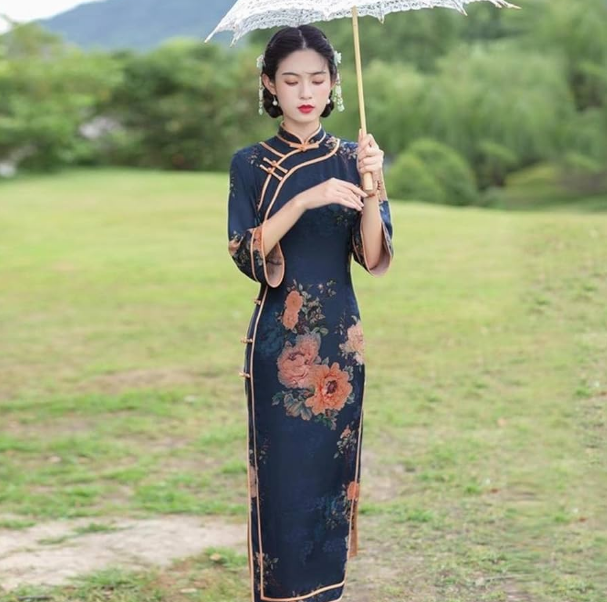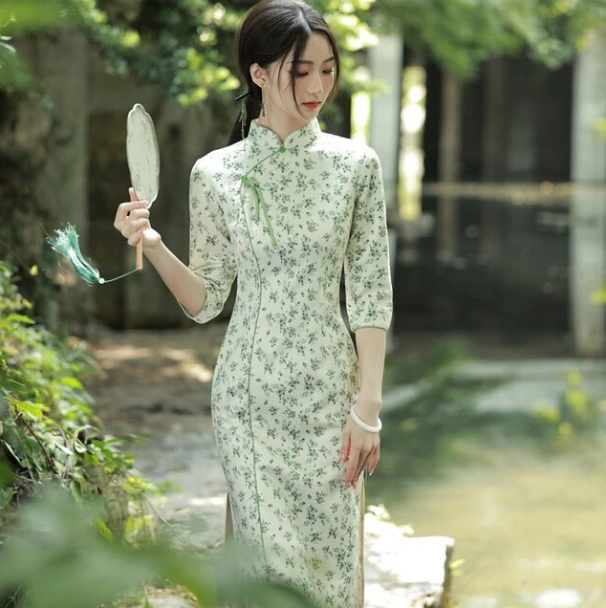Early Beginnings
The cheongsam, as we know it today, has a story that begins in the early 17th century. This dress draws its lineage from the traditional garments worn by the Manchu people, the rulers of China during the Qing Dynasty.
Origin in the Qing Dynasty
When the Manchu established the Qing Dynasty in 1644, they mandated a change in the dress code to reflect their ruling status. The traditional Manchu dress, a loose-fitting and straight-cut robe, served as the precursor to the cheongsam. It was originally intended to facilitate horseback riding and archery, which were vital aspects of Manchu culture, reflecting practicality and agility in design.

Influence from Manchu Dress
The traditional Manchu attire, known as the ‘qipao’, was elegant yet simplistic, characterized by its high neck and wide sleeves. The Manchu dress maintained the wearer’s modesty and was suitable for the cold climates of Northeast China, the Manchu heartland. As the dynasty progressed, this garment began to evolve, with the elite adding intricate embroidery and luxurious fabrics to display their status.
The influence of this attire extended beyond the Manchu nobility as Han Chinese women adopted the qipao, marking the start of its assimilation into broader Chinese culture. Over time, the qipao transformed from its original utilitarian form into a more form-fitting and sophisticated garment. This evolution reflected the changing roles and perceptions of women in Chinese society, especially during the early 20th century.
For a more in-depth look, the Qing Dynasty’s sartorial regulations and the influence on dress can provide a detailed context of the era’s fashion.
Evolution Over Time
The cheongsam has undergone remarkable changes since its inception, with each era adding its flair to the garment.
1920s Shanghai Style Revolution
Shanghai in the 1920s was a melting pot of East and West, and fashion was no exception. The cheongsam became slimmer and more ornate, often featuring exquisite embroidery and beadwork. The city’s tailors started to experiment with the length, sleeve style, and necklines, offering custom fittings that flaunted the wearer’s silhouette.
Influence of Western Fashion
Western fashion brought new materials like wool and velvet to cheongsam design, diversifying its use beyond silk. The introduction of side slits not only modernized the look but also provided practical mobility. Western-style fastenings, such as zippers, began to replace traditional frog buttons, making the garment easier to wear.
To delve into the specifics, one can view the Cheongsam design variations that emerged during this era, showcasing the interplay between Eastern and Western aesthetics.
Cultural Significance
The cheongsam holds a special place in Chinese culture, symbolizing the nation’s fashion history and the evolution of women’s roles in society.
Symbolism in Chinese Society
Each element of the cheongsam carries meaning, from color choices to embroidered motifs. Red, for instance, signifies luck and joy, while dragons and phoenixes on a dress can represent power and femininity. This garment has also become a staple for important events like weddings and New Year celebrations.
Representation in Media and Arts
Films and literature often feature the cheongsam to evoke a sense of nostalgia or to depict elegance and sophistication. Moreover, the dress has been a subject in modern Chinese art, representing the blend of tradition and modernity.
For further details, the Cheongsam’s role in cultural expression can provide additional insight into its significance in various forms of media and arts.
Design and Craftsmanship
The cheongsam is a masterpiece of Chinese sartorial art, showcasing meticulous design and skilled craftsmanship.
Traditional Fabric and Patterns
Silk is the quintessential fabric for traditional cheongsams, revered for its texture and sheen. Patterns often include symbolic elements like bamboo, flowers, and birds, each with distinct meanings. A bamboo motif can denote strength and resilience, while peonies may symbolize wealth and honor.
Tailoring Techniques Through the Ages
Tailors have passed down their techniques for generations, ensuring the art of cheongsam making endures. Early cheongsams were looser, but modern iterations are form-fitting, requiring precise measurements and skilled hand-stitching. A well-made cheongsam can take weeks to complete, reflecting the garment’s quality and the time invested in its creation.
For a comprehensive understanding, explore the intricate details and techniques involved in cheongsam making, including the evolution of patterns and fabrics over time.
Regional Variations
The cheongsam reflects diverse regional characteristics across China, each telling its own cultural story.
Differences Across China
In northern China, cheongsams often feature heavier fabrics to suit the cooler climate, whereas southern styles favor lighter silks. Beijing cheongsams are typically conservative, with high collars and longer sleeves, while those from Shanghai boast bold patterns and a more body-hugging fit.
Adaptations Abroad
Overseas, the cheongsam blends local fashion sensibilities with traditional Chinese elements. For example, in Malaysia and Singapore, the cheongsam includes Southeast Asian fabrics and motifs. The dress has also inspired Western designers, leading to cross-cultural creations that combine the cheongsam’s silhouette with non-traditional materials and designs.
To understand the breadth of the cheongsam’s variations, see the regional adaptations that have spread globally, each with unique features and influences.

The Cheongsam Today
The cheongsam remains a symbol of Chinese identity and fashion, enjoying a resurgence in both traditional and modern forms.
Revival in Modern Fashion
Designers are reimagining the cheongsam with contemporary twists for everyday wear. They incorporate new fabrics, like stretch cotton and blends, making the dress more accessible and comfortable. Fashion shows often spotlight cheongsams, signaling a vibrant comeback on global runways.
Cheongsam as Cultural Heritage
Efforts to preserve the cheongsam are evident across China, with exhibitions and cultural programs promoting its history. The dress is not only a staple during Lunar New Year but also a favored choice for public figures at international events, proudly showcasing Chinese heritage.
To see current trends and the cheongsam’s place in fashion today, one can visit the contemporary cheongsam collections online or through fashion outlets, where its enduring appeal continues to evolve.







